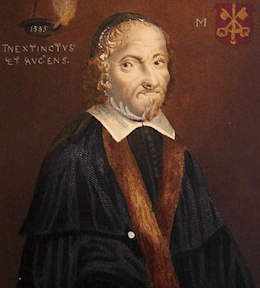Textus Receptus Bibles
Coverdale Bible 1535
| 115:1 | Not vnto vs (o LORDE) not vnto vs, but vnto thy name geue the prayse, for thy louinge mercy and faithfulnes. |
| 115:2 | Wherfore shal the Heithen saye: where is now their God? |
| 115:3 | As for oure God, he is in heauen, he doth what soeuer it pleaseth him. |
| 115:4 | Their ymages are but syluer and golde, euen the worke of mens hodes. |
| 115:5 | They haue mouthes, and speake not: eyes haue they, but they se not. |
| 115:6 | They haue eares, and heare not: noses haue they, but they smell not. |
| 115:7 | They haue handes and handle not, fete haue they, but they can not go, nether can they speake thorow their throte. |
| 115:8 | They that made them, are like vnto them, and so are all soch as put their trust in them. |
| 115:9 | But let Israel trust in ye LORDE, for he is their sucoure & defence. |
| 115:10 | Let the house of Aaron put their trust in ye LORDE, for he is their sucoure & defence. |
| 115:11 | They that feare the LORDE, let the put their trust in the LORDE, for he is their sucoure and defence. |
| 115:12 | The LORDE is myndefull of vs, & blesseth vs: he blesseth ye house of Israel, he blesseth ye house of Aaron. |
| 115:13 | Yee he blesseth all them that feare the LORDE, both small & greate. |
| 115:14 | The LORDE encrease you more & more: you, and youre childre. |
| 115:15 | For ye are ye blessed of the LORDE, which made heauen & earth. |
| 115:16 | All the whole heauens are the LORDES, but the earth hath he geue vnto ye childre of men. |
| 115:17 | The deed prayse not the (o LORDE) nether all they that go downe in to sylence. |
| 115:18 | But we will prayse the LORDE, from this tyme forth for euermore. Halleluya. |

Coverdale Bible 1535
The Coverdale Bible, compiled by Myles Coverdale and published in 1535, was the first complete English translation of the Bible to contain both the Old and New Testament and translated from the original Hebrew and Greek. The later editions (folio and quarto) published in 1539 were the first complete Bibles printed in England. The 1539 folio edition carried the royal license and was, therefore, the first officially approved Bible translation in English.
Tyndale never had the satisfaction of completing his English Bible; but during his imprisonment, he may have learned that a complete translation, based largely upon his own, had actually been produced. The credit for this achievement, the first complete printed English Bible, is due to Miles Coverdale (1488-1569), afterward bishop of Exeter (1551-1553).
The details of its production are obscure. Coverdale met Tyndale in Hamburg, Germany in 1529, and is said to have assisted him in the translation of the Pentateuch. His own work was done under the patronage of Oliver Cromwell, who was anxious for the publication of an English Bible; and it was no doubt forwarded by the action of Convocation, which, under Archbishop Cranmer's leading, had petitioned in 1534 for the undertaking of such a work.
Coverdale's Bible was probably printed by Froschover in Zurich, Switzerland and was published at the end of 1535, with a dedication to Henry VIII. By this time, the conditions were more favorable to a Protestant Bible than they had been in 1525. Henry had finally broken with the Pope and had committed himself to the principle of an English Bible. Coverdale's work was accordingly tolerated by authority, and when the second edition of it appeared in 1537 (printed by an English printer, Nycolson of Southwark), it bore on its title-page the words, "Set forth with the King's most gracious license." In licensing Coverdale's translation, King Henry probably did not know how far he was sanctioning the work of Tyndale, which he had previously condemned.
In the New Testament, in particular, Tyndale's version is the basis of Coverdale's, and to a somewhat less extent this is also the case in the Pentateuch and Jonah; but Coverdale revised the work of his predecessor with the help of the Zurich German Bible of Zwingli and others (1524-1529), a Latin version by Pagninus, the Vulgate, and Luther. In his preface, he explicitly disclaims originality as a translator, and there is no sign that he made any noticeable use of the Greek and Hebrew; but he used the available Latin, German, and English versions with judgment. In the parts of the Old Testament which Tyndale had not published he appears to have translated mainly from the Zurich Bible. [Coverdale's Bible of 1535 was reprinted by Bagster, 1838.]
In one respect Coverdale's Bible was groundbreaking, namely, in the arrangement of the books of the. It is to Tyndale's example, no doubt, that the action of Coverdale is due. His Bible is divided into six parts -- (1) Pentateuch; (2) Joshua -- Esther; (3) Job -- "Solomon's Balettes" (i.e. Canticles); (4) Prophets; (5) "Apocrypha, the books and treatises which among the fathers of old are not reckoned to be of like authority with the other books of the Bible, neither are they found in the canon of the Hebrew"; (6) the New Testament. This represents the view generally taken by the Reformers, both in Germany and in England, and so far as concerns the English Bible, Coverdale's example was decisive.